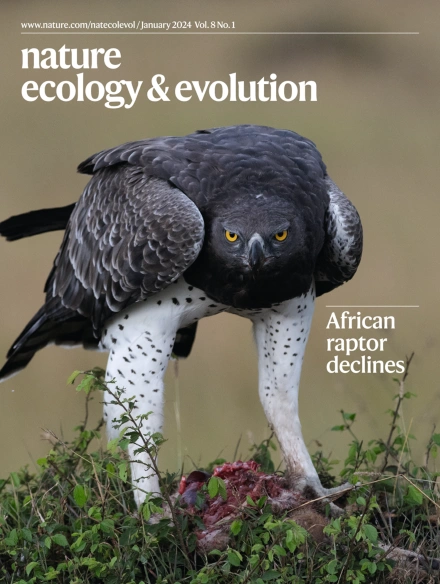全球入侵的黄热病埃及伊蚊种群的适应性基因组特征
IF 13.9
1区 生物学
Q1 ECOLOGY
引用次数: 0
摘要
在虫媒病毒载体埃及伊蚊(Aedes aegypti)中,对人为环境的适应导致了将家养埃及伊蚊(Aaa)生态型与野生埃及伊蚊(Aaf)生态型分离的重大进化转变。Aaa型蚊子分布在全球,比Aaf型蚊子具有更高的媒介传播能力,Aaf型蚊子仍在非洲。尽管这种分离具有进化和流行病学相关性,但不一致的形态数据和复杂的种群结构阻碍了区分这两种生态型的基因组信号的识别。本文分析了511个Aaf和123个Aaa样本的地理分布、群体结构和全基因组选择之间的对应关系,并报告了186个基因的自适应信号,我们称之为Aaa分子特征。我们的研究结果表明,Aaa分子特征来自与Aaf群体中广泛的祖先多态性相关的长期变异,并通过基因组和功能冗余以及局部适应被自我驯化。总的来说,我们表明Ae的行为转变。埃及伊蚊依赖于化学感觉、神经元和代谢功能的精细调节,与人类生活在一起,这在兔和蚕的驯化过程中可以看到。本研究结果也为伊蚊防治新基因靶点的研究奠定了基础。蚊数量。本文章由计算机程序翻译,如有差异,请以英文原文为准。


Adaptive genomic signatures of globally invasive populations of the yellow fever mosquito Aedes aegypti
In the arboviral vector Aedes aegypti, adaptation to anthropogenic environments has led to a major evolutionary shift separating the domestic Aedes aegypti aegypti (Aaa) ecotype from the wild Aedes aegypti formosus (Aaf) ecotype. Aaa mosquitoes are distributed globally and have higher vectorial capacity than Aaf, which remained in Africa. Despite the evolutionary and epidemiological relevance of this separation, inconsistent morphological data and a complex population structure have hindered the identification of genomic signals distinguishing the two ecotypes. Here we assessed the correspondence between the geographic distribution, population structure and genome-wide selection of 511 Aaf and 123 Aaa specimens and report adaptive signals in 186 genes that we call Aaa molecular signatures. Our results indicate that Aaa molecular signatures arose from standing variation associated with extensive ancestral polymorphisms in Aaf populations and have been co-opted for self-domestication through genomic and functional redundancy and local adaptation. Overall, we show that the behavioural shift of Ae. aegypti mosquitoes to live in association with humans relied on the fine regulation of chemosensory, neuronal and metabolic functions, as seen in the domestication processes of rabbits and silkworms. Our results also provide a foundation for the investigation of new genic targets for the control of Ae. aegypti populations. Analysing phylogenetic relationships, genome-wide selective sweeps and genetic differentiation among global populations of Aedes aegypti, the authors identify adaptive signals in 186 genes related to self-domestication that distinguish the globally distributed non-African ecotype from its African ancestor.
求助全文
通过发布文献求助,成功后即可免费获取论文全文。
去求助
来源期刊

Nature ecology & evolution
Agricultural and Biological Sciences-Ecology, Evolution, Behavior and Systematics
CiteScore
22.20
自引率
2.40%
发文量
282
期刊介绍:
Nature Ecology & Evolution is interested in the full spectrum of ecological and evolutionary biology, encompassing approaches at the molecular, organismal, population, community and ecosystem levels, as well as relevant parts of the social sciences. Nature Ecology & Evolution provides a place where all researchers and policymakers interested in all aspects of life's diversity can come together to learn about the most accomplished and significant advances in the field and to discuss topical issues. An online-only monthly journal, our broad scope ensures that the research published reaches the widest possible audience of scientists.
 求助内容:
求助内容: 应助结果提醒方式:
应助结果提醒方式:


